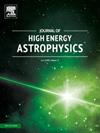Dark energy constraints using gamma-ray burst correlations with DESI 2024 data
IF 10.5
4区 物理与天体物理
Q1 ASTRONOMY & ASTROPHYSICS
引用次数: 0
Abstract
Even though the Dark Energy Spectroscopic Instrument (DESI) mission does not exclude a dynamical dark energy evolution, the concordance paradigm, i.e., the ΛCDM model, remains statistically favored, as it depends on the fewest number of free parameters. In this respect, high redshift astrophysical sources, such as gamma-ray bursts, represent a formidable tool to model the form of dark energy, since they may provide a link between early and local redshift regimes. Hence, the use of these objects as possible distance indicators turns out to be essential to investigate the cosmological puzzle. To this end, we adopt two gamma-ray burst linear correlations, namely the and relations, to test the flat and non-flat ΛCDM, CDM, and CDM cosmological models, i.e., those directly examined by the DESI collaboration. The inferred correlation coefficients and cosmological parameters are thus obtained by considering two independent Monte Carlo Markov chain analyses, the first considering the whole DESI data set and the second excluding a seemingly problematic data point placed at . Using model selection criteria, the two above correlations do not show a preference on a precise cosmological model although, when the data point at is included, the concordance paradigm appears to be the least favored among the tested cosmological models.
利用伽马射线暴与DESI 2024数据相关的暗能量约束
尽管暗能量光谱仪器(DESI)的任务并不排除动态暗能量演化,但协和范式,即ΛCDM模型,仍然在统计上受到青睐,因为它依赖于最少数量的自由参数。在这方面,高红移天体物理源,如伽马射线暴,代表了一个强大的工具来模拟暗能量的形式,因为它们可能提供早期和局部红移制度之间的联系。因此,使用这些物体作为可能的距离指示器,对于研究宇宙之谜至关重要。为此,我们采用两种伽马暴线性相关,即Lp−Ep和L0−Ep−T关系,来检验平坦和非平坦ΛCDM、ω0CDM和ω0ω1CDM宇宙学模型,即由DESI合作直接检验的模型。因此,推断出的相关系数和宇宙学参数是通过考虑两个独立的蒙特卡罗马尔可夫链分析得到的,第一个考虑整个DESI数据集,第二个排除了一个看似有问题的数据点,位于zeff=0.51。使用模型选择标准,上述两种相关性并没有显示出对精确宇宙学模型的偏好,尽管当包括zeff的数据点时,一致性范式似乎是被测试的宇宙学模型中最不受欢迎的。
本文章由计算机程序翻译,如有差异,请以英文原文为准。
求助全文
约1分钟内获得全文
求助全文
来源期刊

Journal of High Energy Astrophysics
Earth and Planetary Sciences-Space and Planetary Science
CiteScore
9.70
自引率
5.30%
发文量
38
审稿时长
65 days
期刊介绍:
The journal welcomes manuscripts on theoretical models, simulations, and observations of highly energetic astrophysical objects both in our Galaxy and beyond. Among those, black holes at all scales, neutron stars, pulsars and their nebula, binaries, novae and supernovae, their remnants, active galaxies, and clusters are just a few examples. The journal will consider research across the whole electromagnetic spectrum, as well as research using various messengers, such as gravitational waves or neutrinos. Effects of high-energy phenomena on cosmology and star-formation, results from dedicated surveys expanding the knowledge of extreme environments, and astrophysical implications of dark matter are also welcomed topics.
 求助内容:
求助内容: 应助结果提醒方式:
应助结果提醒方式:


